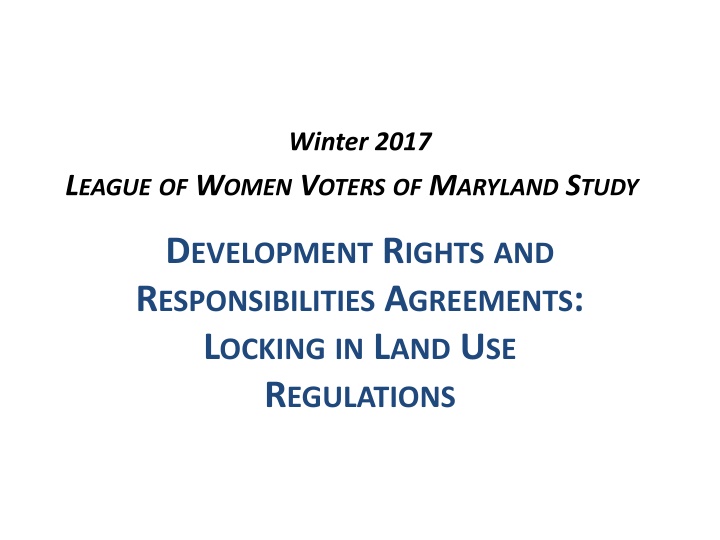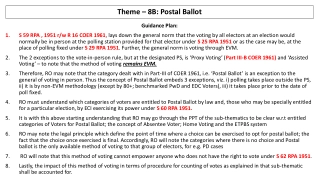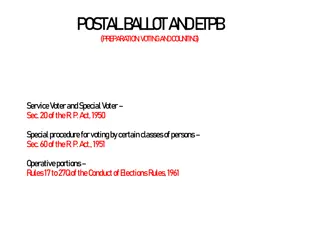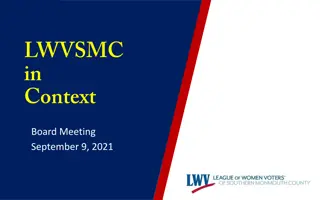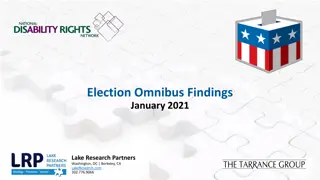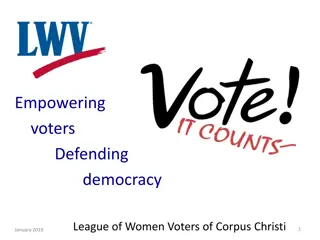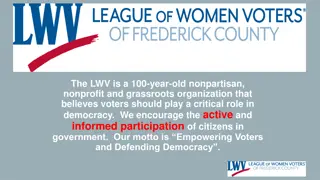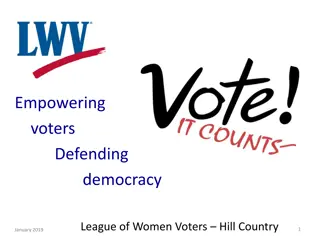League of Women Voters Study on DRRA Impacts in Maryland
This study by the League of Women Voters of Maryland focuses on Development Rights and Responsibilities Agreements (DRRAs) to assess their use and impact in Maryland. The goal is to determine if revising Maryland's DRRA legislation is necessary. Explore the history, positions, and implications of DRRAs in land-use policies.
Download Presentation

Please find below an Image/Link to download the presentation.
The content on the website is provided AS IS for your information and personal use only. It may not be sold, licensed, or shared on other websites without obtaining consent from the author.If you encounter any issues during the download, it is possible that the publisher has removed the file from their server.
You are allowed to download the files provided on this website for personal or commercial use, subject to the condition that they are used lawfully. All files are the property of their respective owners.
The content on the website is provided AS IS for your information and personal use only. It may not be sold, licensed, or shared on other websites without obtaining consent from the author.
E N D
Presentation Transcript
Winter 2017 LEAGUE OF WOMEN VOTERS OF MARYLAND STUDY DEVELOPMENT RIGHTS AND RESPONSIBILITIES AGREEMENTS: LOCKING IN LAND USE REGULATIONS
This study focuses on the use and impact of DRRAs in Maryland. Goal of the study: to determine if the State League should consider a position on revising Maryland s DRRA enabling legislation.
LWV Positions on Land Use LWVUS has a long history of promoting land- use policies that manage land as a finite resource and that incorporate principles of stewardship. LWVMD has taken action to encourage the State to establish goals, guidelines and standards for land use, with local implementation of land use policies.
LWV Positions on Land Use League of Women Voters of Frederick County studied local use of DRRAs in 2014 and recommended that Frederick County government use DRRAs strategically for high-density development projects in defined areas, to secure public infrastructure contributions from developers that are significantly greater than would otherwise be required.
Whats a DRRA? An agreement between a developer and a local government that provides developers with the means to vest certain rights to develop property under the zoning and regulations in place at the time of execution of the agreement. In exchange for this early vesting, there is the expectation that the developer will provide public benefits above and beyond what would otherwise be required.
Whats Vesting? The point at which a developer s rights cannot be taken away by local government through changes in zoning or land-use regulations. Maryland has a strict late-vesting rule: Zoning and land-use rules for an approved project are not guaranteed until foundations are visible coming out of the ground.
DRRA Law Enacted in 1995 Development Rights and Responsibilities Agreements are a land-use tool created by the Maryland General Assembly in 1995 to address developers concerns about the state s late- vesting rule. Development projects were becoming larger and more complex, requiring capital-intensive infrastructure and longer lead time before visible construction could get under way.
Win-Win DRRAs were intended to be a win-win for both the developer and the local government, providing both with benefits that would not otherwise be available.
Win-Win For the developer: A DRRA was intended to provide certainty that land use regulations and zoning will not change for the entire term of the DRRA. For local officials: A DRRA was expected to provide an opportunity to negotiate greater contributions for public facilities than could otherwise be required as well as to encourage development where growth is seen as desirable.
Key Provisions of Enabling Legislation Contents are to include: Duration of the agreement Permissible uses of the property Density or intensity of use Maximum height and size of structures Statement that the development is consistent with the Comprehensive Plan Any requirements necessary to ensure the public health, safety and welfare To the extent applicable, provisions for dedication of a portion of the property for public use, protection of sensitive areas, preservation/restoration of historic structures, and construction or financing of public facilities
Key Provisions of Enabling Legislation Time limitation 5 years unless otherwise established, or extended by amendment Termination By mutual consent If local governing body can show that suspension or termination is essential to ensure the public health, safety, or welfare
Use of DRRAs by MD Counties Since 1995, eleven Maryland counties adopted DRRA ordinances. Queen Anne s has since repealed its DRRA ordinance (in 2004). DRRA ordinances are on the books in Anne Arundel Calvert Caroline Charles Dorchester Frederick Howard Kent St. Mary s Talbot
Use of DRRAs by MD Counties This study focuses on the four counties that have made the greatest use of these agreements: Anne Arundel Queen Anne s Frederick Charles
Anne Arundel County Odenton Town Center, 40 year term 130 acres (part of 1,233 acres included in the Odenton Town Center Management Plan) Mixed use, in urban setting with access to adequate transportation and transit facilities Good example of a Smart Growth project: Developer is expediting construction of an essential transportation corridor. Located in an area targeted by the county for transit-oriented development.
Anne Arundel County Benefits both the public and the developer: Developer agreed to design, engineer and construct the Town Center Boulevard near the MARC rail line with sidewalks, bike paths and other amenities for public use. County agreed to provide sewer and water capacity sufficient to support the full 3.5M square feet of mixed-use development.
Anne Arundel County Local development laws will be frozen for the 40-year term of the DRRA which is the anticipated time it will take for build-out of the entire Town Center project. Customary county fees, taxes and charges will be due at the rates in effect at the time of development (not frozen at the rates in effect when the DRRA is signed).
Anne Arundel County This was considered an ideal project and location for use of a DRRA to secure essential infrastructure. However, county planners do not anticipate another DRRA project in the foreseeable future, due to the time required to negotiate such an agreement and the availability of other land-planning tools to manage growth.
Queen Annes County Four Seasons Development, 20 year term On Kent Island near Rts 50 & 301 and Bay Bridge DRRA allocated responsibilities between the developer and the county for public facility improvements necessitated by the 1,079 unit residential development. Developer provided above and beyond cash payments to the county not related to facilities improvements. Seen by critics as a relatively small amount given the size of the project.
Queen Annes County Has been tied up in litigation for 14 years. Opponents have raised concerns about adverse environmental impacts on waterways and tidal wetlands located almost entirely in Critical Area traffic congestion
Queen Annes County Opponents also have raised concerns about an approval process that lacked political legitimacy DRRA was executed by outgoing county commissioners after all had been defeated in primary elections by candidates strongly opposed to the project.
Frederick County 14 DRRAs executed 2012-2014; terms of 15-25 years Total of 5,000 acres; 9,800 new dwelling units Enacted by a Board of County Commissioners whose majority had pledged to restore property rights to owners of land downzoned by the prior Board. New commissioners revised the County Comprehensive Plan, approved a number of rezonings, and modified the Adequate Public Facilities Ordinance (APFO) requirements for contributions from developers.
Frederick County Most controversial APFO change was an amendment that provided a new option, the School Construction Fee, in areas where schools were at capacity or overcrowded. Allowed developers of residential projects to proceed in areas where schools were at or above capacity. This option has been eliminated from the APFO as of July 2016; it is not available for new developments going forward, although it is locked into DRRAs.
Frederick County All the DRRAs allow residential development in areas where schools are at or over capacity, in exchange for School Construction Fees. If not for the School Construction Fee, these developers would have had only two options: to construct the required public school facilities or to wait for the public school facilities to become adequate. Not all of the DRRAs appear to require developers to contribute more for public facilities or infrastructure than would have been required in the regular approval process.
Frederick County Six of the 14 projects are in Priority Funding Areas, where state funds for new/ expanded infrastructure are most likely to be directed. All freeze the building excise tax at 0 for the entire term of the agreement. There has been opposition by citizens groups to some of the DRRAs. Overall, these DRRAs raise concerns about adequacy of public facilities, particularly schools.
Charles County 21 DRRAs executed 2013-2015; terms of 5-15 years County had used DRRAs as a forward-funding mechanism for the State share of school construction funding. DRRAs allowed developers to exceed the capacity of schools beyond the APFO requirement in exchange for payment of various fees per excess student allocation.
Charles County As of March 2016, the county decided to no longer consider, negotiate or execute a DRRA in which school allocations are issued in exchange for a payment. DRRAs that had already been approvedwere not impacted by this policy change. The approved DRRAs raise concerns about potential school overcrowding.
Advantages and Disadvantages The effective use of DRRAs as a planning tool requires balancing and protecting the interests of both the developer and the local jurisdiction in managing growth and providing needed infrastructure. In their application, DRRAs have seldom been the clear win-win proposition envisioned when the enabling legislation was enacted.
Advantages and Disadvantages Predictability Certainty that zoning and land-use rules will not change before vesting would otherwise occur is important for developers of large complex projects. DRRAs enhance their ability to secure financing for upfront infrastructure, such as transportation/ transit facilities, water and sewer lines, and streets.
Advantages and Disadvantages Public Benefits Local government benefits when it negotiates agreements that require developers to provide public infrastructure and facilities greater than what would otherwise be required spur development in a priority growth area The language in the legislation regarding above-and- beyond public benefits is not explicit. However, a MD Court of Special Appeals opinion (filed 2-3- 17) held that one DRRA in Frederick County is void for lack of enhanced public benefits.
Advantages and Disadvantages Smart Growth DRRAs can be a valuable tool for local governments in encouraging new development in line with Smart Growth policies and in Priority Funding Areas. The best example is the DRRA in Anne Arundel County.
Advantages and Disadvantages Duration and Scope State enabling legislation specifies an initial five-year term for DRRAs unless otherwise agreed to by the County and the developer, or extended. DRRAs of a decade or more can tie the hands of future elected leaders in responding to changing needs, conditions and fiscal constraints.
Advantages and Disadvantages Modification/Termination DRRAs can be terminated by mutual consent. Otherwise, they cannot be easily undone. A local government can only suspend or terminate a DRRA, after a public hearing, if officials can show that the change is essential to ensure the public health, safety or welfare of residents. This can be a difficult case to make and may result in costly litigation.
Advantages and Disadvantages In summary, experience has shown that DRRAs can be a useful land-use tool. Yet significant concerns have been identified in the application of Maryland s DRRA legislation by local governments.
Consensus Questions The consensus questions focus on whether the DRRA enabling legislation should be reviewed and adjusted and, if so, what key issues should be addressed to ensure more focused and strategic use of DRRAs going forward.
1. Should the Maryland Legislature review the DRRA enabling legislation and consider clarifications and possible limitations? 2. If yes, what limitations and clarifications should be discussed? A. To explicitly state the expectation that DRRAs require developers to provide public infrastructure contributions beyond what would otherwise be required. B. To limit the use of DRRAs to large projects that advance needed public infrastructure. C. To limit DRRAs to Priority Funding Areas, in line with Smart Growth policies. D. To limit duration of DRRAs by making the 5-year time limit specified in the enabling legislation mandatory for all DRRAs, with the option for approval of future extensions. E. To limit the scope of DRRAs by adding a provision that DRRAs may not freeze fees. F. To require that when a petition for a DRRA is filed by a developer, the county must post a notice on the property as well as other means to alert the public at an earlier stage in the application/approval process.
3. Should the local government be required to quantify the potential public benefits of every DRRA prior to its approval? 4. If the term of a DRRA exceeds 5 years, should there be a provision to require periodic review of DRRAs and to develop a process for revision/termination of a DRRA because of significant changes in circumstances? (This would be language broader than the current provision allowing for termination only to ensure public health, safety, or welfare.) 5. If the current DRRA statute is not modified to address concerns discussed in this Fact Sheet, should consideration be given to repealing the DRRA enabling legislation?
